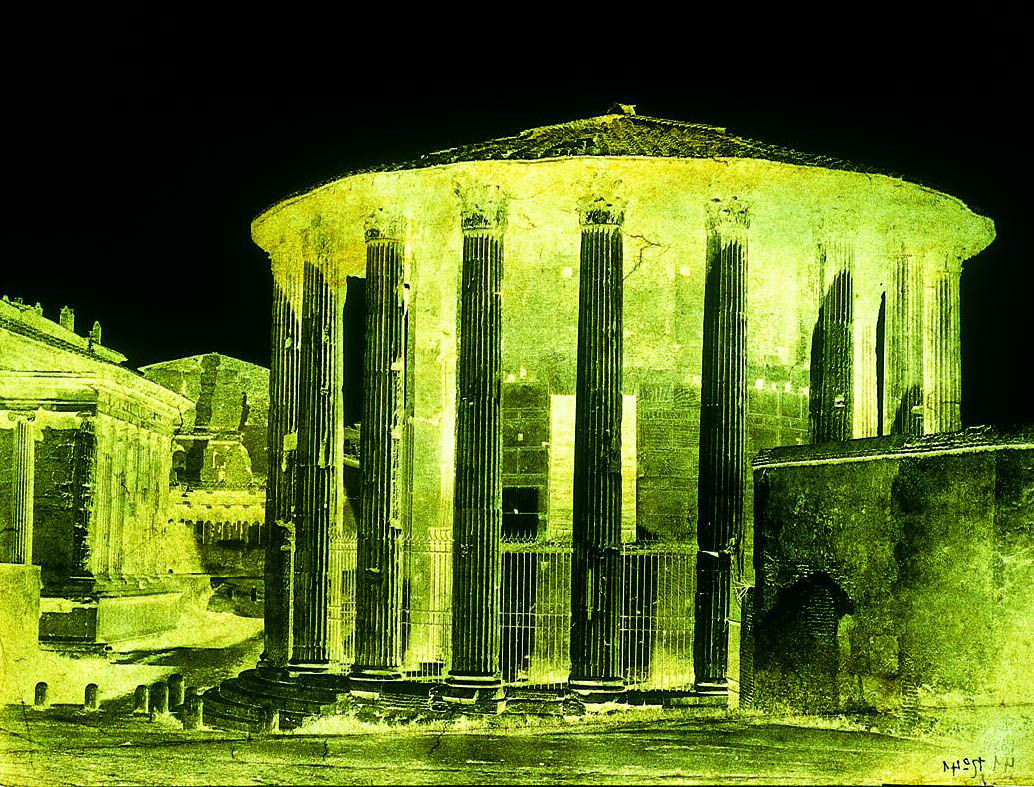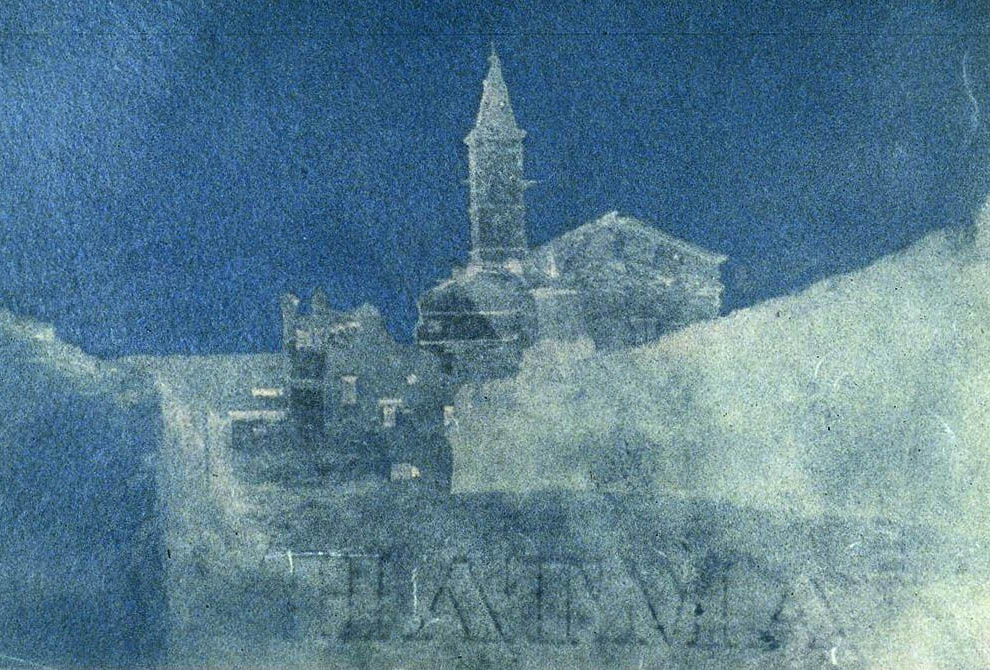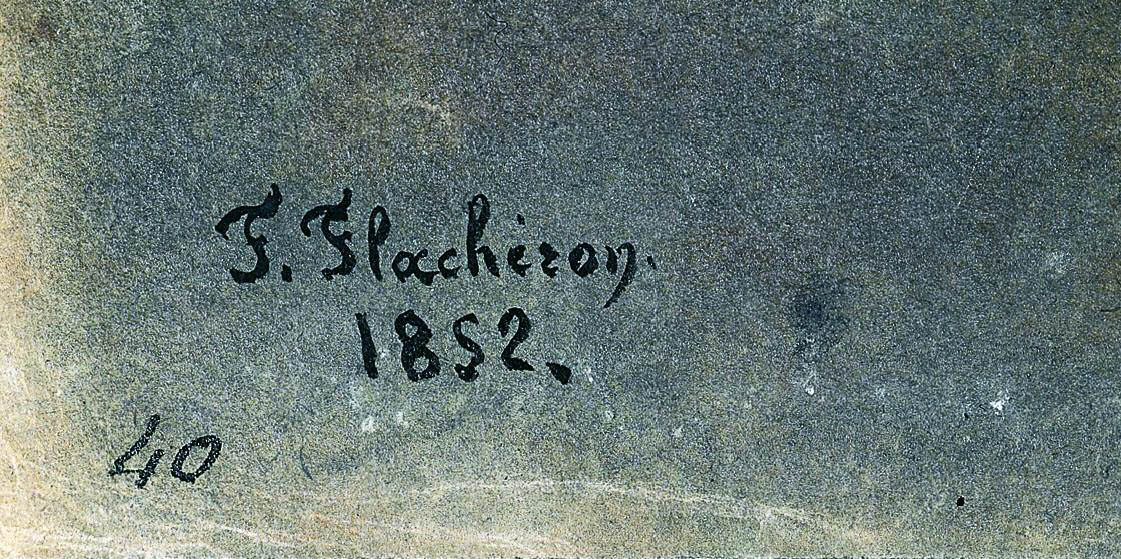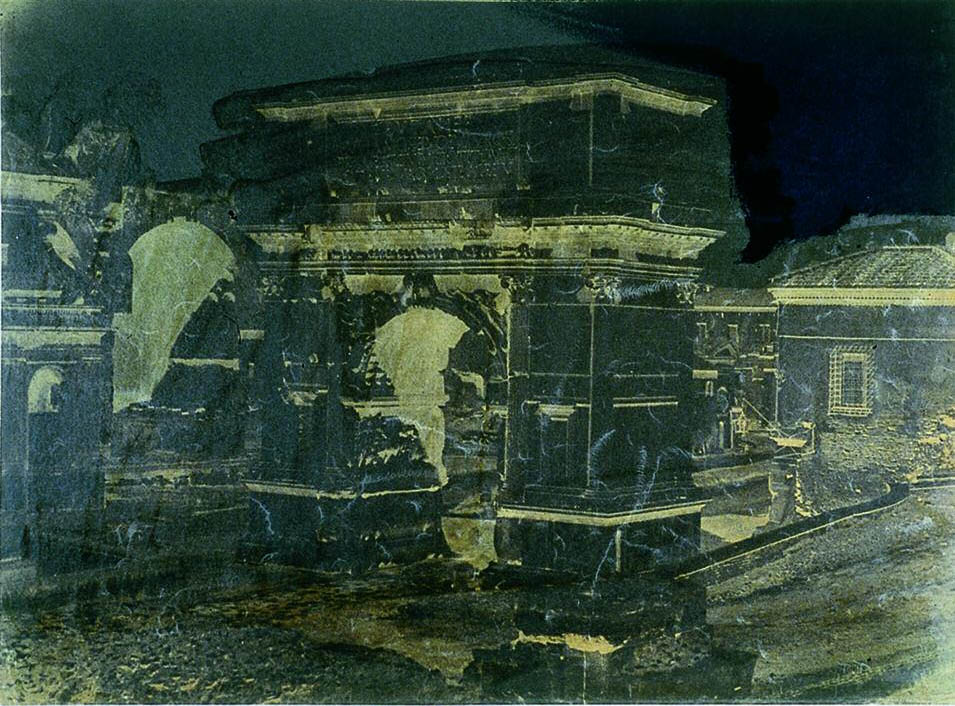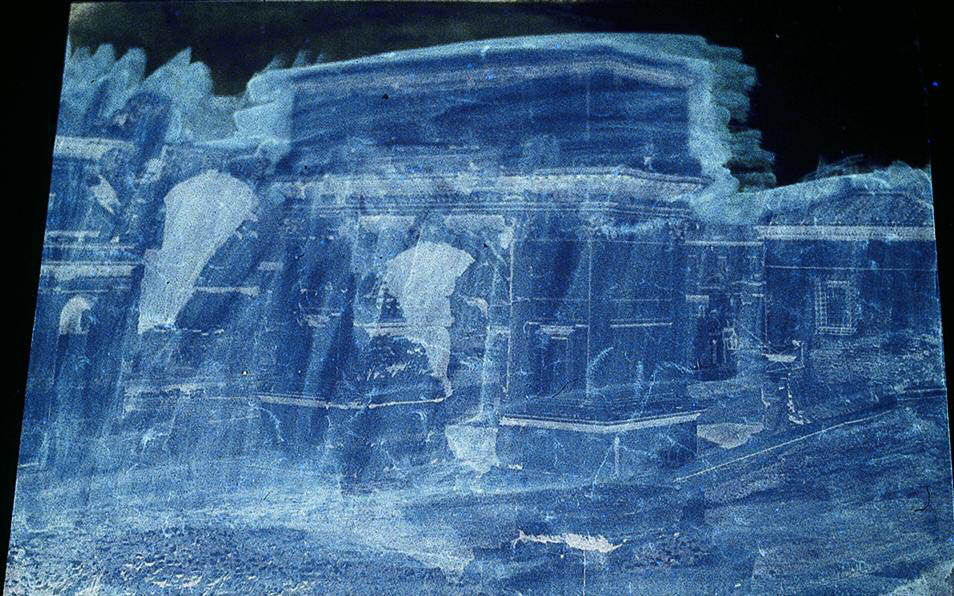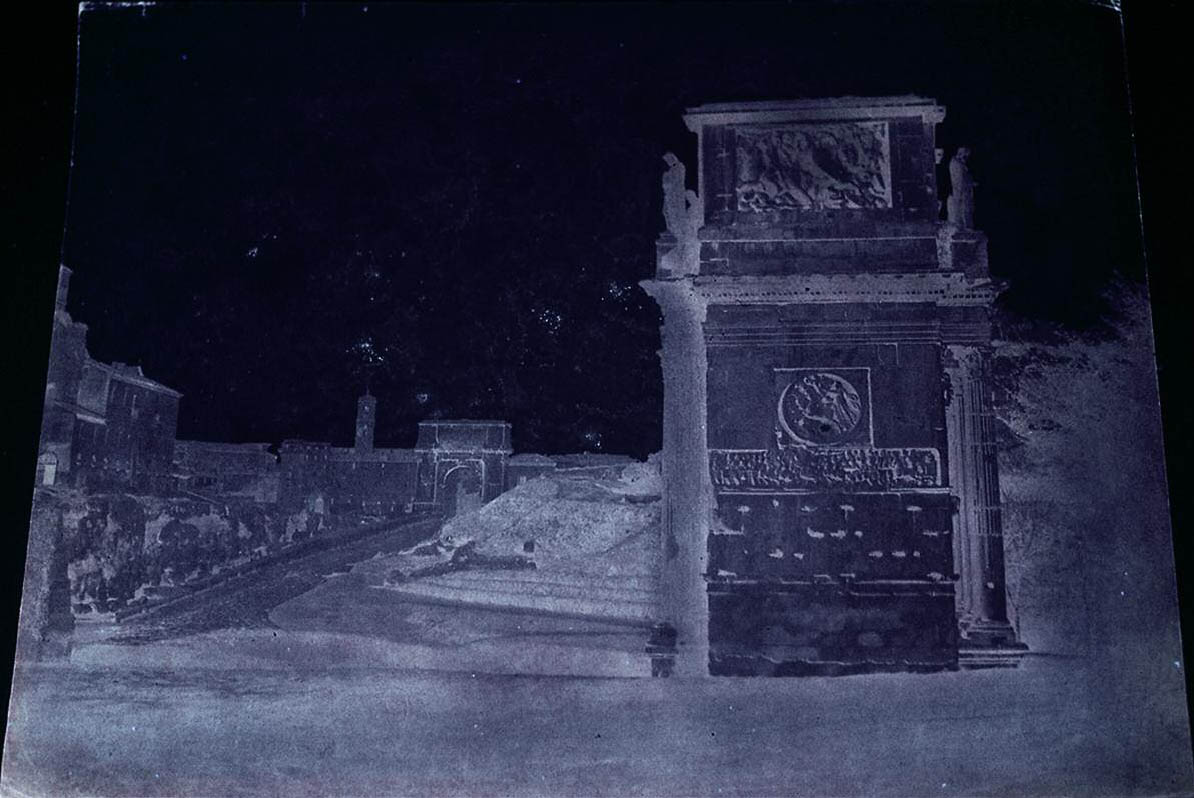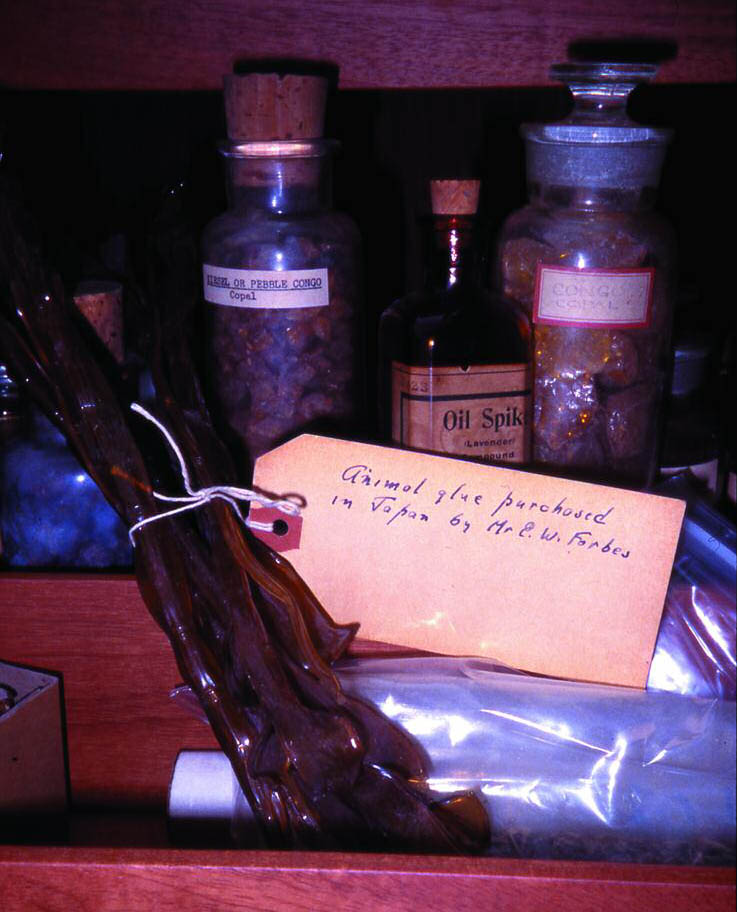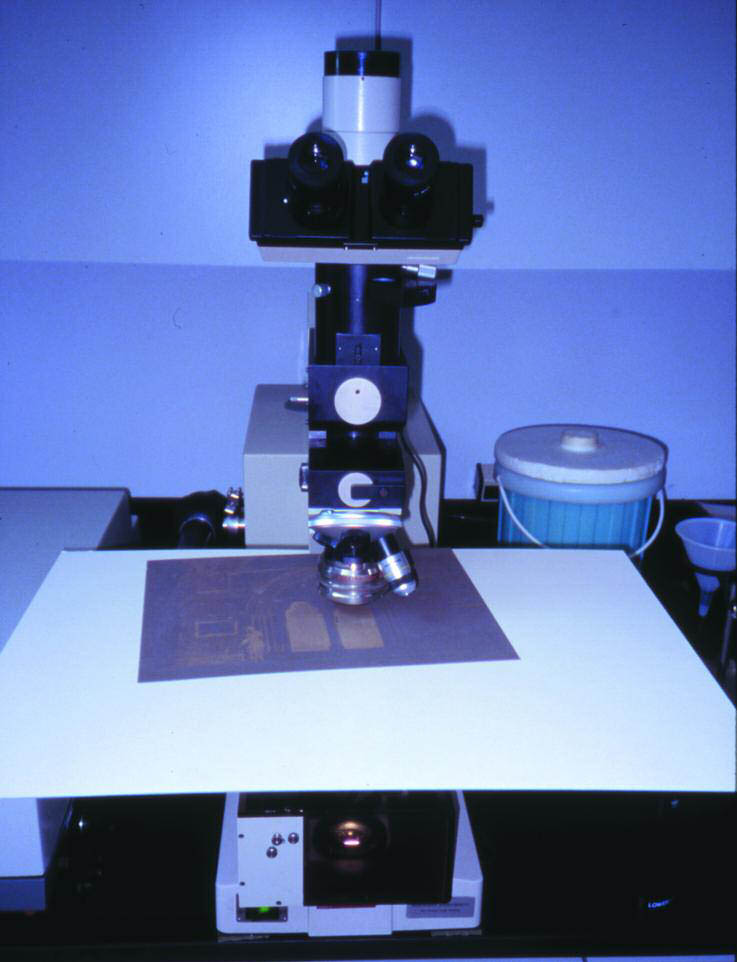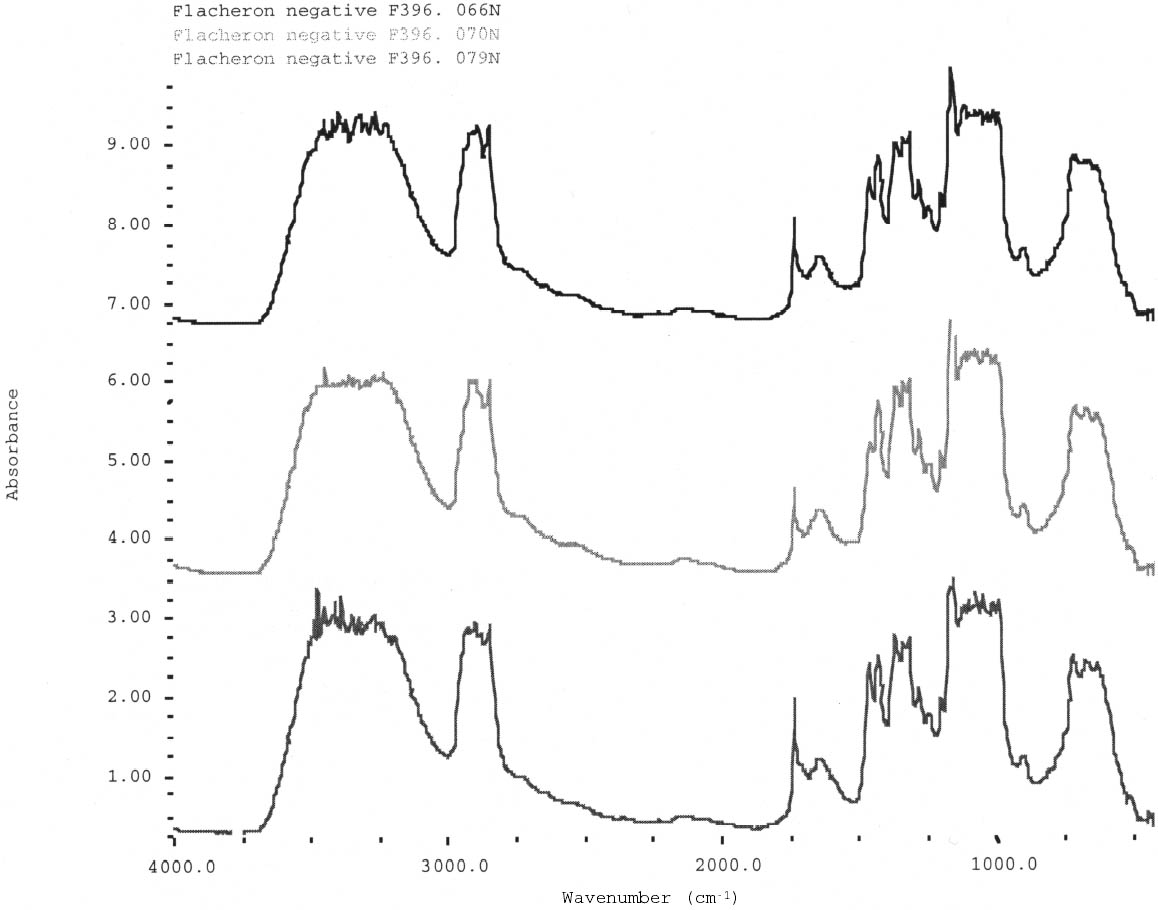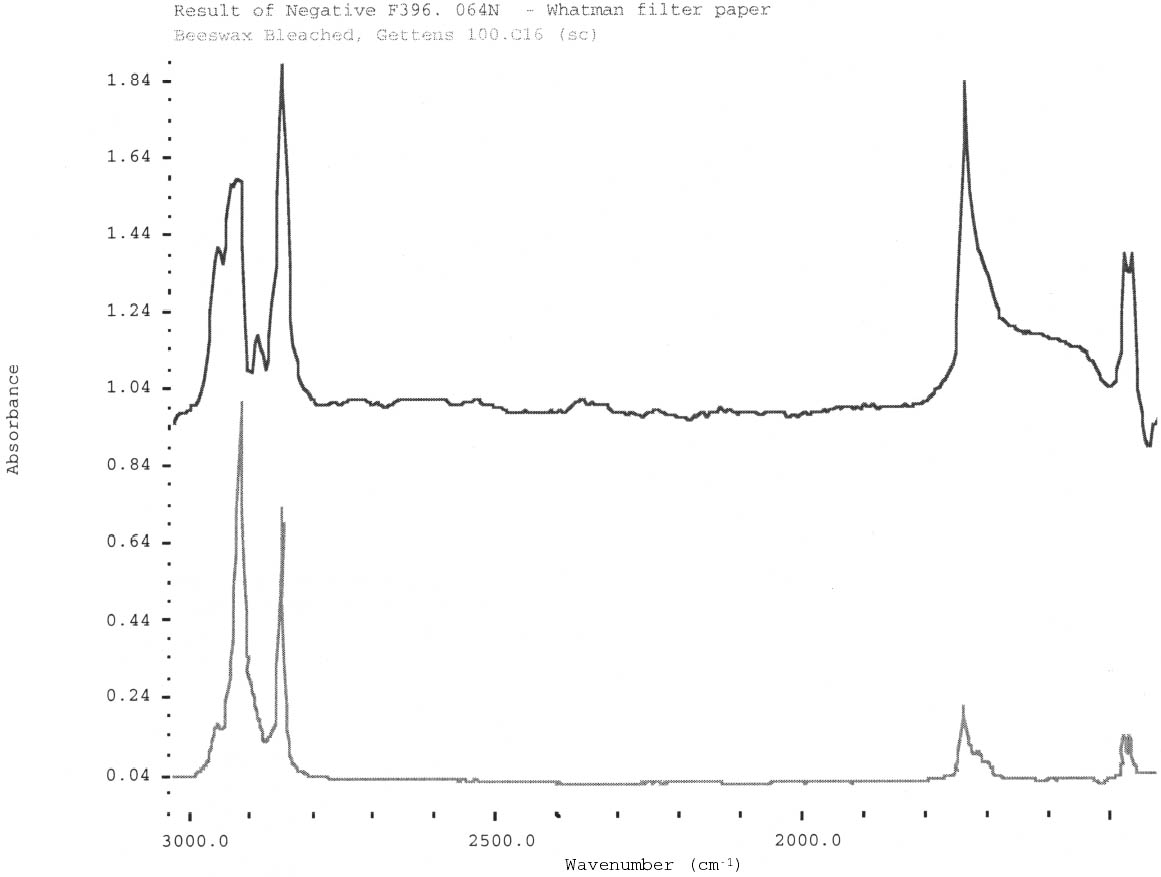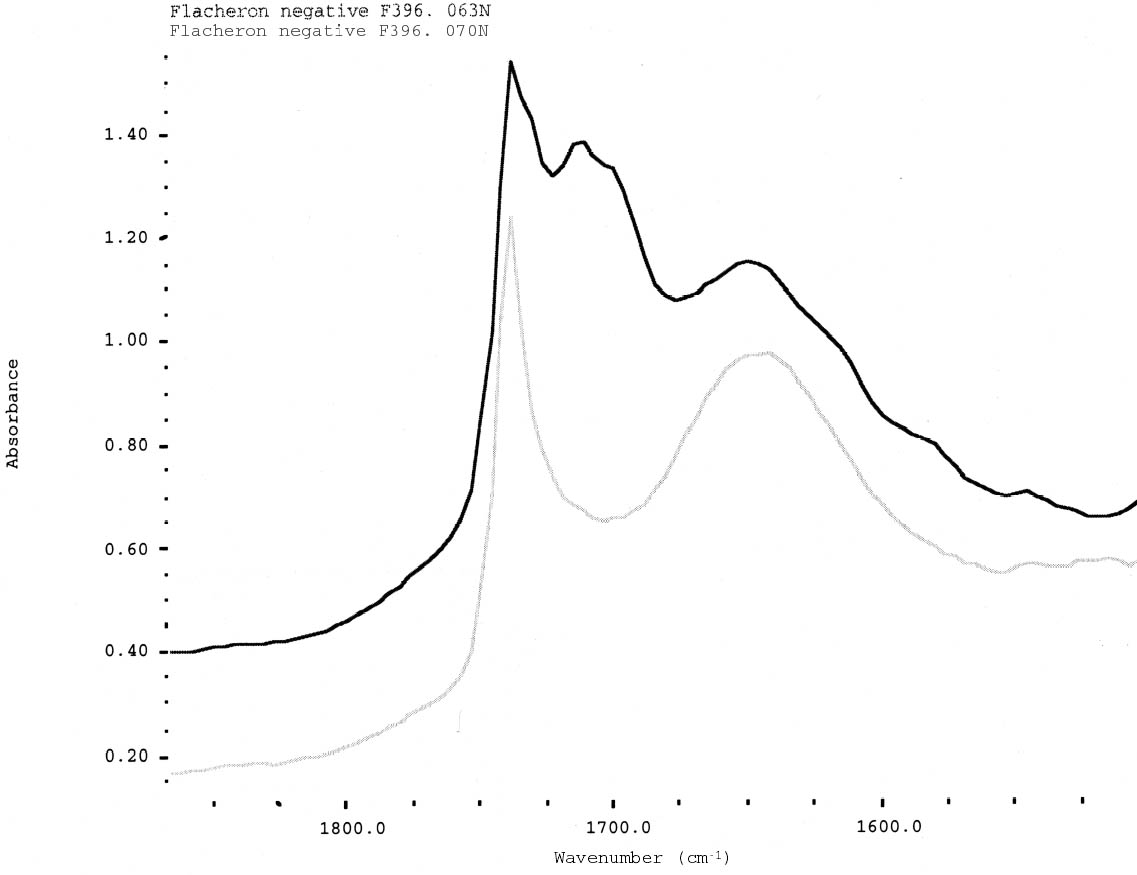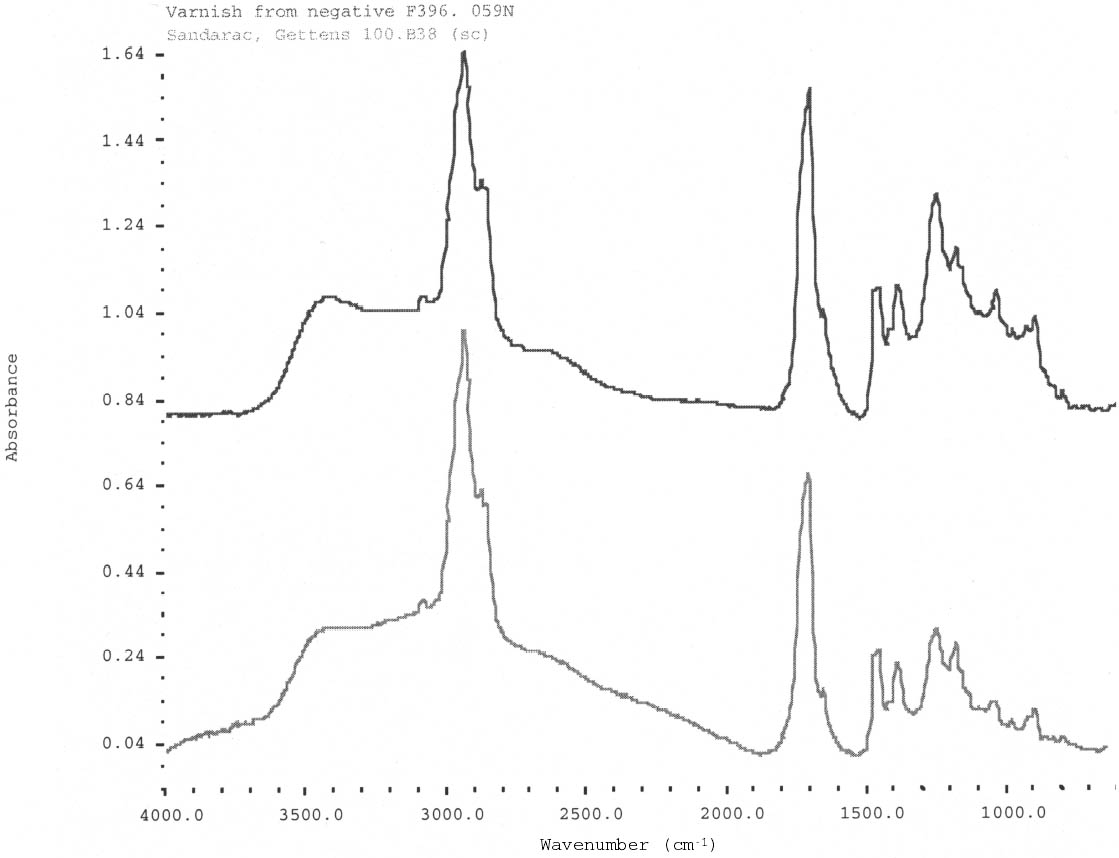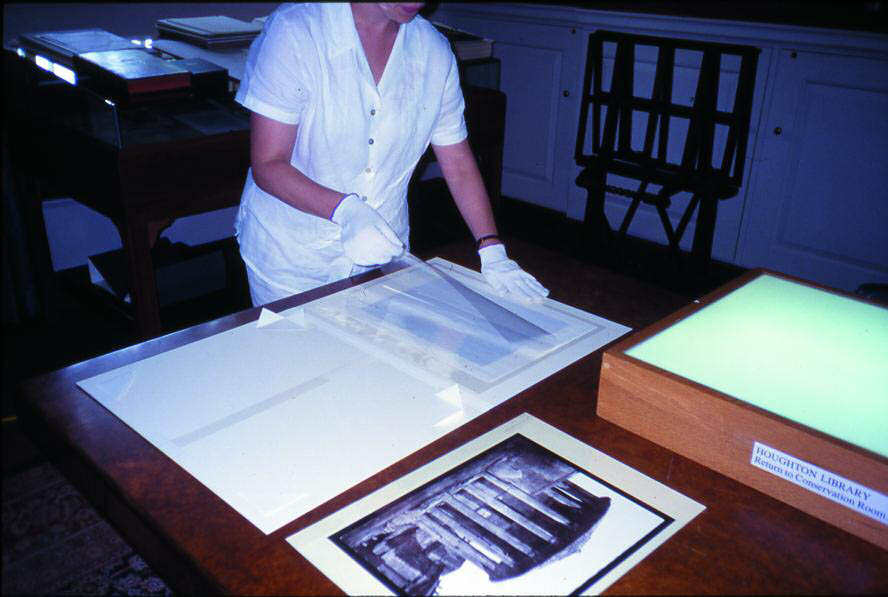“A TRANSPARENT ATMOSPHERE”: THE PAPER NEGATIVES OF FR�D�RIC FLACH�RON IN THE HARRISON D. HORBLIT COLLECTIONLEE ANN DAFFNER
ABSTRACT—Jean-Fran�oise-Charles-Andr� Flach�ron, Count Fr�d�ric Flach�ron, was born in 1813 in Lyons, France. Trained as a painter and sculptor, in 1839 he moved to Rome after winning the second Grand Prix de Rome. Between 1848 and 1853 Flach�ron systematically photographed the great architectural monuments of Rome and its environs using a variant of Henry Talbot's paper negative process, the calotype. To date, approximately 155 negatives by Flach�ron are known to have survived; the Harrison D. Horblit Collection of Early Photography at the Houghton Library at Harvard University contains 37. The examination and analysis of this important group of paper negatives became the focus in a Conservation Treatment Grant jointly sponsored by the Getty Grant Program and the Department of Printing and Graphic Arts, Houghton Library. Of primary interest in the study was the identification and interpretation of coatings found on the Flach�ron negatives, during which several methods of analysis were employed. TITRE—“Une atmosph�re transparente”: Les n�gatifs sur papier de Fr�d�ric Flach�ron dans la collection Harrison D. Horblit. R�SUM�—Jean-Fran�ois Charles-Andr� Flach�ron, comte Fr�d�ric Flach�ron, est n� en 1813 � Lyon, France. Ayant �tudi� la peinture et la sculpture, il s'installe � Rome en 1839, apr�s avoir remport� le deuxi�me Grand Prix de Rome. Entre 1848 et 1853 Flach�ron a syst�matiquement photographi� les grands monuments de Rome et de ses environs en utilisant une variante du proc�d� de n�gatif sur papier d'Henry Talbot, le calotype. Aujourd'hui, on conna�t approximativement 155 n�gatifs r�alis�s par Flach�ron; la collection Harrison D. Horblit de photographies anciennes � la Houghton Library at Harvard University (biblioth�que Houghton de l'universit� de Harvard) en d�tient 37. L'examen et l'analyse de ce groupe important de n�gatifs sur papier sont devenus l'objet principal d'une bourse de traitement de conservation commandit�e conjointement par le Getty Grant Program (Programme de bourses du Getty) et le Department of Printing and Graphic Arts (d�partement des techniques d'impression et des arts graphiques) de la biblioth�que Houghton. L'identification et l'interpr�tation des enduits trouv�s sur les n�gatifs de Flach�ron furent d'un int�r�t tout particulier au cours de cette �tude, et plusieurs m�thodes d'analyse ont �t� utilis�es � cet effet. TITULO—“Una atm�sfera transparente”: los negativos sobre papel de Fr�d�ric Flach�ron en la Colecci�n Harrison D. Horblit. RESUMEN—JEAN Fran�oise-Charles-Andre Flach�ron, Conde Fr�d�ric Flach�ron, naci� en Lyon, Francia, en 1813. Formado como pintor y escultor, se instalo en Roma en 1839 tras haber ganado el segundo Grand Prix de Roma. Entre 1848 y 1853, Flach�ron fotografio sistem�ticamente los grandes monumentos arquitect�nicos de Roma y sus alrededores, utilizando una variante del proceso fotogr�fico introducido por Henry Talbot (el calotipo) para producir negativos sobre papel. A la fecha se sabe de 155 negativos, aproximadamente, que sobrevivieron en diferentes colecciones; 37 de ellos se conservan en la colecci�n de Fotografia Temprana de la Houghton Library at Harvard University (Biblioteca Houghton de la Universidad de Harvard). El ex�men y an�lisis de este importante grupo de negativos se realizo gracias fondos otorgados para tratamientos de conservaci�n por el Programa de Subvenciones de la Getty Grant Program (Fundaci�n Getty) con la colaboraci�n del Department of Printing and Graphic Arts (Departamento de Artes Graficas e Impresiones) de la Biblioteca Houghton. El estudio estuvo enfocado a la identificaci�n e interpretaci�n de los materiales utilizados como recubrimiento en los negativos sobre papel de Flach�ron. Para ello se utilizaron diversas t�cnicas anal�ticas. T�TULO—“Uma atmosfera transparente”: os negativos em papel de Fr�d�ric Flach�ron na Cole��o Harrison D. Horblit. RESUMO—Jean-Fran�oise-Charles-Andre Flach�ron, Conde Fr�d�ric Flach�ron, nasceu em 1813, em Lyon, Fran�a. Formado em pintura e escultura, mudou-se para Roma, em 1839, ap�s vencer o segundo Grand Prix 1 INTRODUCTIONThe examination and analysis of the Fr�d�ric Flach�ron paper negatives were initiated to advance our understanding of these important 19th-century photographic artifacts while addressing the preservation needs of all 364 paper negatives in the Harrison D. Horblit Collection of Early Photography. The project, completed in 1998, was one facet in a year-long Conservation Treatment Grant jointly sponsored by the Getty Grant Program and the Department of Printing and Graphic Arts in Houghton Library of Harvard University. Flach�ron, who trained at the French Academy of Art, transferred traditional art materials and techniques to photography. These material components were the focus of a technical investigation, including Fourier transform infrared (FTIR) spectroscopy and gas chromatography. The preservation and stabilization of this collection included an item-level examination, creation of a database to record the survey findings, photographic documentation, design and fabrication of a paper negative rehousing system, and guidelines for the care and handling of these fragile artifacts. 1.1 FR�D�RIC FLACH�RONJean-Fran�oise-Charles-Andr� Flach�ron, Count Fr�d�ric Flach�ron, was born in 1813 in Lyons, France, to an extensive artistic family, one of numerous children of Louis Flach�ron, the town architect. Fr�d�ric and his brother Isidore both studied under notable artists of the day: Fr�d�ric with the sculptor and medalist Pierre-Jean David D'Angers (1788–1856), and Isidore with the painter Jean-Auguste-Dominique Ingres (1780–1867). In 1839 Flach�ron won the second Grand Prix de Rome and moved to the “Eternal City.” There he met Caroline Hayard (fig. 1), proprietress of a shop selling artist's supplies on the Piazza di Spagna (Rouillac 1987). The two married in 1842 (Helsted 1978). Caroline, born in 1810, grew up among artists such as Ingres, who was director of the French Academy of Rome at the time and an intimate friend of the Hayard family. The Flach�rons had three children and lived in Rome until 1867 when they moved to Paris, where they stayed for the remainder of their lives (Naef 1966, 1977). The Hayard shop and the Flach�ron home were located near the historic Caf� Gr�co, a well-known and important meeting place for artistic circles (fig. 2).
Between 1848 and 1853, perhaps catalyzed by his training in sculpture and his father's architecture, Flach�ron systematically photographed the great structures and views of Rome and environs with a paper negative process (fig. 3, see page 446). It is not certain where or from whom Flach�ron learned photography, but by February 1849 he was producing such astonishing prints that his works were eagerly being collected by members of his circle. “Flach�ron has made some masterpieces lately. They
The details of Flach�ron's arrangement with his print dealers have not been fully researched. In 1852 three individuals in London—Antoine Claudet, a photographer; Mark Anthony, an artist; and Hippolyte Bailli�re, a publisher of French medical books—owned his prints. These three loaned prints from their collections to the first large-scale photographic exhibition held in Britain. This exhibition was hosted by the Society of Arts, London, and it opened to widespread acclaim at the society's premises in December 1852. The following year, 1853, Flach�ron's prints were being sold through the Photographic Institution, Bond Street, London, a venture established by Joseph Cundall and Philip Delamotte. The relatively high price of Flach�ron's prints, at 15 shillings each, places them at the high end of the market when compared to the work of other photographers represented by the Photographic Institution (Taylor 2002). 1.2 FLACH�RON'S PAPER NEGATIVE PROCESSRare and delicate, the paper negative was the first means by which photographers could make multiple positive prints. One-hundred and fifty-five negatives by Flach�ron are known to exist; 37 are now in the Horblit Collection. Flach�ron's circle used a process first publicly described by Louis-D�sir� Blanquart-Evrard to the Paris Academy of Sciences in January 1847, which is a variant of Henry Talbot's calotype process (Talbot 1841). It came to be known as either the Roman method or as the wet paper process. “The work of Fr�d�ric Flach�ron, who works by a modification of the Roman Process,” reported the Art Journal, “possesses many beauties, mainly due to the transparent atmosphere in which he operates” (Art Journal 1853, 56). The process begins by choosing a high-quality, smooth, wove paper (fig. 4, see page 446). In Flach�ron's case, 10 of the 37 negatives studied showed full or partial Whatman paper watermarks, and all were found to measure .003 in. (76.2 microns) when measured with a Starrett no. 223 paper micrometer caliper. (For comparison, a page from the JAIC journal measures on the average .004 in. or 101.6 microns).
Photographic Notes reported:
The negatives fall neatly into two size formats: the small negatives measure 7 � 8� in. (17.78 � 21.59 cm), while the large format dimensions are, on the average, 10 � 14 in. (25.4 � 35.56 cm). According to the published accounts of Flach�ron's method, the paper is cut to size and coated with a salting solution of potassium iodide. The paper can be stored indefinitely at this stage. To complete the sensitization, the iodized paper is placed face down on the glass of the negative holder previously coated with a solution of silver nitrate and acetic acid. It is kept damp by several layers of moist backing paper. A final sheet of glass completes the package, which is placed into the negative holder and into the camera for exposure while the negative is still damp (Thomas 1852). This wet procedure kept the light-sensitive chemistry in a humid, reactive atmosphere and ready for the day's photographic excursions. Paper negative photographers of the 1850s could modify their photographic processes when traveling in hot, southern climates where unexposed, sensitized negative papers would easily spoil. In addition to the damp paper, there was a second modification that rendered the wet paper process particularly well suited to use in warm weather. This was the addition of potassium bromide to a salting solution composed primarily of potassium iodide, first used by Antoine Gaudin in 1841 (Gaudin 1841). In a simplified explanation of the photochemistry, of the three silver halides, silver iodide reacts the most rapidly to light;
Three published reports of Flach�ron's process relate similar procedures, materials, and chemical solutions (Thomas 1852; Photographic Notes 1856; American Journal of Photography 1865). After a four–six minute exposure in the camera, the negative is ready for development. The latent image is amplified in a developing solution of saturated gallic acid for approximately 20 minutes. In this reaction, the developing agent (gallic acid) donates electrons to the silver ions present so that metallic silver is catalytically produced on the surface of the latent image. As this coating or plating of the latent image continues, the particles physically enlarge, and consequently the image grows to a visible size, resulting in a neutral, gray image, consistent with a form of development known as physical development (Haist 1979). Interestingly, the developed image was stabilized in a solution of potassium bromide before being fixed with sodium thiosulphite (Thomas 1852). Given the overall uniformity of the negatives, the consistency of papers, and the high quality of images produced with exceptional detail, it can be concluded that Flach�ron probably used the same process for all the paper negatives examined in the Horblit Collection. To prepare the negatives for printing, all 37 Flach�ron negatives were evenly saturated with wax to increase transparency. In addition, Flach�ron used two methods of retouching. In the first, powdered graphite was rubbed into the paper surface to increase the opacity of various areas, which would result in subtle gradations (see figs. 4, 5, page 446). This technique can be seen in the work of Benjamen Brecknell Turner at the Royal Photographic Society in Bath, England, and by Victor Prevost at the George Eastman House in Rochester, New York. For stronger effects, usually to the sky, a black opaquing medium such as heavy gouache was applied (fig. 6, see page 446). Both methods of retouching would yield corresponding lighter areas in the positive print. Flach�ron signed and dated most of his negatives with gouache, black ink, or graphite pencil. These inscriptions appear on the topmost surface of the paper negative, that is, on top of the waxed surface, ranging in date from 1849 to 1853 (fig. 7, see page 447).
2 CONDITION OF THE FLACH�RON NEGATIVESThis group of early photographic artifacts is extraordinary: strong, clear compositions produced with confidence using beautiful materials. The small-format negatives date from 1849 to 1850, and the large-format negatives are dated from 1850 to 1853 as well as being inscribed with a number. Overall the Flach�ron negatives are in very good condition, despite inherent fragility. Throughout the group, the image silver is neutral colored and appears stable. Flach�ron consistently employed the highest-quality Whatman paper for his negatives, and despite wear and tear from handling, the sheets have survived intact and in fact retain some of their original flexibility. Craquelure was observed in the gouache retouch media, although active flaking was not noted.
Visual inspection of the four negatives showed that the resinous coating was selectively applied to the negative: brush strokes outline the building forms but do not cover the surface completely. The thickness varies considerably from area to area, and a distinct cracking pattern from handling dents suggests the layer is brittle. All of the Flach�ron negatives were examined under long-wave ultraviolet light. A visible fluorescence from ultraviolet excitation at certain wave-lengths is characteristic of specific substances, and long-wave ultraviolet radiation is frequently used, for example, in paintings conservation, to help distinguish overpaint from original paint or to ascertain the presence of natural resin varnishes or shellac. Four of the negatives examined under ultraviolet light showed a very strong, telltale, greenish auto-fluorescence typically associated with natural resin varnish. These were the same four negatives with coatings visible under normal illumination (fig. 10, see page 447). No other negative examined showed fluorescence (fig. 11, see page 448).
While many of the photographic journals and manuals from this period of photography suggest that beeswax was the preferred transparentizing agent, other materials were available to and utilized by the photographers, such as oil, other waxes such as paraffin wax, gums, and resins (Blanch�re 1865). Beeswax has long been known for its chemical stability, due to its fully saturated long chain polymer components and the stability of the ester linkage. However, the addition of resins and gums, a practice historically associated with wax working, is of significance to the natural aging of these artifacts (Mills and White 1977). 3 ANALYSIS OF THE NEGATIVESThe identification and interpretation of these coatings were material in understanding Flach�ron's working process. Was he experimenting with different waxes and resin admixtures? Could specific discoloration in the negatives be attributed to the aging of a specific resin? Identification and evaluation of these components became the focus of the analysis. Instrumental analysis was undertaken at the Straus Center for Conservation at the Harvard University Art Museums, with Amy Snodgrass, associate conservation scientist. Fourier transform infrared spectroscopy yields spectra in the midinfrared region for organic and inorganic compounds present in or on a sample. The identification of a material from its infrared spectrum generally requires an assignment of its band positions and intensities as well as comparison to spectra of known materials. This procedure can be straightforward with pure samples; however, as is often the case with historic objects, samples may have aged or contain a mixture of materials, greatly complicating the proper assignment of functional groups. The Gettens Collection of Aged Materials at the Straus Center for Conservation is a unique and valuable resource. It contains organic materials traditionally used by artists, such as waxes, resins, gums, and glues (fig. 12, see page 448). Since this reference library has undergone some aging of its own, it provides the opportunity to construct a reference of aged samples. In 1993, Amy Snodgrass and Beth Price of the Philadelphia Museum of Art created a spectral library from 267 samples from the Gettens Collection of Aged Materials. Key samples underwent systematic verification by alternate means, confirming their spectra with published data. Because it is composed primarily of traditional fine art painting materials, this reference collection was considered appropriate for the evaluation of the negatives. Due to his artistic training and close associations with professional
3.1 INSTRUMENTAL METHOD: FTIRFTIR microspectroscopy was performed using a Spectra-Tech IR-Plan microscope attached to a Nicolet 510M spectrometer with an auxiliary MCT detector. The FTIR spectrometer at the Straus Center has an attached microscope, which is designed for the analysis of microscopic samples. For our purposes, however, a mat board platform with a small portal for the infrared beam was fabricated and secured to the stage of the FTIR microscope. Initially it was of overriding interest to utilize a nondestructive method for analysis, so the following system was developed. The paper negative was positioned on top of the platform, and a spectrum was gathered from each negative as the infrared beam passed through the sheet of paper in transmittance mode (fig. 13, see page 448). Two hundred scans were averaged at a spectral resolution of 8 cm-1. The resulting spectra were viewed in absorbance mode between 625 and 4,000 wavenumbers. Random areas for analysis were chosen on each negative, located in the highlights where very little or no silver image was present, usually near the center of the image. The procedure took about 15 minutes per negative.
3.2 INTERPRETATIONThe spectra produced by nondestructive transmittance showed absorbances both for paper and for any materials that Flach�ron might have applied to it (fig. 14). The paper was too thick for adequate transmittance of the infrared beam for the strongest absorbing frequencies. The strong bands between 3000 and 3600 wavenumbers for O-H and between 2800 and 3000 wavenumbers for C-H and between 1000 and 1200 wavenumbers in the spectral fingerprint region are cut off. Although the thickness of the paper caused a loss of information for the strongest bands, it had the unanticipated benefit of enhancing the weaker bands. Most of the absorbances in the spectra are for cellulose; however, the prominent absorbance at 1737 in the carbonyl region indicates the presence of another material. To identify this component, the cellulose absorbances were mathematically subtracted from the spectrum. For subtraction we used a spectrum from an analytical grade filter paper, Whatman no. 4 Qualitative, which is 99% pure cellulose and similar in thickness to the negative paper. The result of the subtraction suggested absorbances characteristic of beeswax, possibly with an admixture (fig. 15). To evaluate these findings, the decision was made to augment analysis with gas chromatography—mass spectrometry (GC-MS). This decision was carefully considered due to two factors: the samples for GCMS require destructive sampling, and the wax and resin layers are extremely thin, limiting the actual amount of material available. Therefore the sampling was taken near the edge of the paper and, when possible, from a previously damaged area, and away from the silver image. The aid of a stereomicroscope ensured that the amounts retrieved were small enough that there was no visible alteration to the area. The exact quantity of sample retrieved was roughly equivalent to the period at the end of this sentence. This amount is slightly smaller than the amount normally required for GC-MS. Richard Newman, research scientist, performed the GC-MS analysis at the Museum of Fine Arts, Boston. The resulting compounds confirmed the presence of beeswax and a hydrocarbon wax, such as paraffin. From the initial visual examination of 32 negatives, it appeared that 8 might contain a high resin content. With FTIR, 4 were found to contain absorbances for resin (fig. 16). To further evaluate these findings, microscopic samples of resin were removed from the surface of four negatives following our sample-taking protocol and analyzed by FTIR. The four spectra were identical, with a 98% match to the Gettens references for sandarac resin (fig. 17). GC-MS performed on a sample from one of the negatives suggested the varnish was a mixture of oil, sandarac, and pine resin. These findings underscore several limitations to consider when undertaking analytical investigation of extremely thin layers, such as with the paper negatives. In this project, it was of paramount importance 4 THE COATINGThirty-two Flach�ron negatives at the Bibliotheque Nationale in Paris were visually examined, and only two exhibited coatings similar to those analyzed in the Houghton Library. Therefore, from a total of 69 Flach�ron negatives examined in this study, only 6 appear to have resin applications. Something important to Flach�ron warranted the extra step with these paper negatives, certainly for the production of the final positive print. Further study of these specific views of Rome may shed light on which images were in demand for printing and exhibition. Flach�ron's application of the coating is selective, as opposed to overall, suggesting he wanted to alter or improve the image. He may have thought it would further enhance the details of the image by locally increasing the transparency of the paper, as resins will render paper more transparent than wax. If the coating had been applied overall, it could be shown that the resin was possibly meant as a protective layer, such as the varnish on a wet collodion negative, protecting the image from abrasion and chemical staining by soluble silver salts. Although none of the negatives are coated
The presence of sandarac provides some information on the working properties of the resin coating and why Flach�ron may have incorporated it into his coating. Sandarac is soluble in alcohol and will dry quickly to form a thin, hard varnish, which makes it easy to use and able to adhere to a waxed coating on the lightweight Whatman paper used by Flach�ron. As early as 1804, sandarac is mentioned as a component in varnishes “destined for articles subject to friction, such as furniture, chairs, fan-sticks, mouldings, etc., and even metals, to which it may be applied with success. The sandarac gives it great durability” (Tingry 1804, 119). By 1833, recipes for alcohol-based varnishes for paintings containing sandarac and alcohol can be found (Carlyle 1991). These fast-drying varnishes are also mentioned in relation to retouch varnishes. In 1888, sandarac varnishes for glass plate negatives were noted for their ability to “admit any amount of retouching with plumbago” (Burbank 1888, 170). Graphite retouch is present on both the recto and verso of many Flach�ron negatives, although a direct correlation between the two components was not observed. 5 PRESERVATION MEASURES FOR THE PAPER NEGATIVESEach physical aspect of the paper negatives presented important preservation concerns to be addressed in their examination and rehousing: thin, delicate papers, loose or friable retouch media, and the presence of waxes and resins warrant special consideration during
A computer database using FileMakerPro 4.0 was created to collect information from the survey and to complement the existing bibliographic database for the Harrison D. Horblit Collection of Early Photography. The item-level object survey consists of a description addressing overall condition, handling, and manipulation observations relating to original fabrication, process identification, and both general and specific material aspects of each individual artifact. The survey form specifies the four primary material components of each negative: final image material, primary support, transparentizer, and media. The database allows the researcher to compare specific areas of interest throughout the collection through keyword searches. For example, it facilitates quick and accurate searches of paper negatives with
Each paper negative was photographed recto and verso with 35 mm Ektachrome 160T professional color slide film. Details were taken of inscriptions, and a selection of negatives was photographed through transmitted light. All slides were labeled and placed into archival binders. Researchers will be asked to consult the slides before selecting negatives to be retrieved from the storage for viewing, thus reducing wear and undue handling of the object. A storage enclosure in two sizes was designed and fabricated for this collection. The small negatives fit easily into a 11 � 14 in. folder, while the large negatives fit into folders measuring 16 � 20 in. These standard-size folders are placed into archival-quality clamshell boxes. The use of standard-size enclosures is recommended for uniformity and safe retrieval of the artifacts. Each negative is placed first between two sheets of lightweight, smooth-finish, archival-quality paper, such as Photo-Tex, which is then inserted into a 5 mil Mylar sleeve. The package is secured into a four-ply mat board folder with four paper photocorners. The two photo-corners at the outside edge of the folder are secured with archival-quality pressure-adhesive tapes. The two photo-corners at the seam of the folder are secured but cut in such a manner that they can be opened in order to slide the Mylar sleeve onto a viewing surface (fig. 18, see page 448). All materials in direct contact with the photographic artifacts passed the photographic activity test (PAT) of ISO 14523 (ISO 1999). Handling guidelines (see appendix 1) are kept with the negatives and are a critical component of the long-term preservation of these materials.
6 CONCLUSIONSIt seems the conservator's mission to balance an equal concern for both the past and the future, and the Flach�ron negatives at the Houghton Library, set a magnificent challenge. First and foremost, their stability and longevity had to be ensured through new procedures of housing and handling, or future research and manipulation would eventually destroy them. Yet the specifics of these procedures were entirely dependent on the individual coating of each negative. An understanding of Flach�ron's method was critical. The historical record of 19th-century photography is relatively thorough; scientific journals and eventually photographic publications provided instruction as to prevailing methods and give an inkling of the types of coatings Flach�ron may have used. But in the early 1850s, neither techniques nor materials were standardized in the way they became a half-century later. This situation made examination of each negative imperative in this study. A great deal could be surmised about Flach�ron's coatings from observation, since they exhibit different physical characteristics, but verification required analysis. Exploration of a nondestructive application of FTIR suggested the presence of beeswax and sandarac resin on a group of the Flach�ron paper negatives. GC-MS analysis confirmed the presence of sandarac and beeswax and detected the presence of a pine resin, an unidentified oil, and other constituents that were not detected by FTIR. The technique may warrant further experimentation when used in conjunction with other analytical methods. Both FTIR and GC-MS, used in tandem, proved quite useful in ascertaining the individual coatings. While it is always preferable to use only nondestructive analysis, to be absolutely certain about the coatings a few minute samples had to be taken. These results are, it is to be hoped, only the beginning of a database that will aid future research. Using technology to understand art is certainly an irony not lost on a conservator, but it is nowhere more poignant that at the dawn of photography. Though its evolution can be seen as a series of technical innovations, photography's first generation was steeped in pretechnological traditions, particularly the fine arts in Flach�ron's case. When he embraced this new technology, he brought to it techniques of drawing and painting that allowed him to manipulate his negatives to an aesthetic end. Perhaps in this way, Flach�ron used art to understand technology. ACKNOWLEDGEMENTSThe author gratefully acknowledges the generous support of the Getty Grant Program, the Harvard University Library, and the Department of Printing and Graphic Arts at Houghton Library for making this project possible. The technical analysis was conducted largely by Amy Snodgrass and Richard Newman, who both gave tremendously of their time and expertise. My heartfelt thanks to Anne Anninger, Martin Bansbach, Craigen Bowen, Laura Cocheran, James Coddington, Hans P. Kraus Jr., Christopher McGlinchey, Julie Melby, Jan Merrill-Oldham, Doug Nishimura, Sylvie Penichon, Grant Romer, Roger Taylor, Mike Ware, and Scott Williams. APPENDIXAPPENDIX 1 GUIDELINES FOR STORAGE AND HANDLING OF 19TH-CENTURY PAPER NEGATIVES1 Storage Guidelines
2 Handling Guidelines
3 Exhibition Guidelines
4 Monitoring Guidelines
REFERENCESAmerican Journal of Photography. 1865. Negative photography on paper—Flach�ron's process. American Journal of Photography8(7):165–66 Art Journal. 1853. Photography exhibition at the Society of Arts. Art Journal5:56. Blanch�re, H.1865. R�pertoire encyclop�dique de photographie. Paris: Bureau de la R�daction D'Abonnement et de Vente. Burbank, W. H.1888. The photographic negative. New York: Scovill Manufacturing Company. Carlyle, L. A.1991. A critical analysis of artist's handbooks, manuals and treatises on oil painting published in Britain between 1800–1900: With reference to selected eighteenth-century sources. Ph. D. diss., Courtauld Institute of Art, University of London. Gaudin, A.1841. M. Gaudin �crit relativement � de nouvelles modifications qui'il a introduites dans les proc�d�s photographiques. Comptes Rendus Hebdonmondaires des S�ances de L'Acad�mie des Sciences13(16):832. Haist, G.1979. Modern photographic processing. New York: John Wiley and Sons. Helsted, D.1978. Rome in early photographs. History of Photography2(4):335–46.
ISO. 1999. Photography: Processed photographic materials, Photographic activity test for enclosure ISO. 2000. Imaging materials: Processed photographic reflection prints, Storage practices, 18920. Geneva: International Organization for Standardization. Mills, J. S., and R.White. 1977. Natural resins of art and archaeology: Their sources, chemistry, and identification.Studies in Conservation22:12–31. Naef, H.1966. Ingres et la famille Hayard.Gazette des Beaux-Arts20:37–50. Naef, H.1977. Die Bildniszeichnungen von J.-A-D. Ingres. Bern: Bentelli. Nishimura, D.1999. Personal communication. Image Permanence Institute, Rochester Institute of Technology, Rochester, N. Y. Perez-Rioja, J. A.1981. Un Caf�-Museo de Roma: El “Greco. ” Goya Revisista de Arte164–65:120–23 Photographic Notes. 1856. On photographic paper. Photographic Notes6(3):10–11 Richard, P. M.1996. Auguste Ravier photographe: L'aquarelle aux sels d'argent. In Fran�ois-Auguste Ravier, 1814–1895. Lyons: Mus�e des Beaux-Arts de Lyon. 74–77. Rouillac, P.1987. Photographies anciennes: Succession du Comte Fr�d�ric de Flach�ron. March 22. H�tel des Ventes, Vend�me. Smith, J. S.1857. Abstract of Mr. T. Shaw Smith's paper on the calotype or wet-paper process. Journal of the Photographic Society3(April 21):257. Talbot, H. F.1841. The process of Talbotype (formally called calotype) photogenic drawing. Communicated to the Royal Society, June 10, 1841London: J. L. Cox and Sons. Taylor, R.2002. Photographs exhibited in Britain, 1839–1865. Ottawa: National Gallery of Canada. Thomas, R. W.1852. Photography in Rome.Art Journal4:159–60. Tingry, P. F.1804. The painter and varnisher's guide. London: G. Kearsley, Fleet-Street. Williams, S.2002. Personal communication. Department of Chemistry and Chemical Engineering. South Dakota School of Mines and Technology, Rapid City, S. Dak. FURTHER READINGBlackwell, J.1977. Infrared and raman spectroscopy of cellulose.American Chemical Society Symposium Series48:206–18. Blanquart-Evrard, L. D.1851. Trait� de photographie sur papier. Paris: Librairie Encyclop�dique de Roret. Brettell, R., R.Fluckinger, et al. 1984. Paper and light: The calotype in France and Great Britain, 1839–1870. London: David Godine. Daffner, L.1995. Examination and survey of nineteenth-century paper negatives.Topics in Photographic Preservation6:1–10. Delamotte, P. H.1853. The practice of photography: A manual for students and amateurs. London: Joseph Cundell. Derrick, M.1989. Fourier transform infrared spectral analysis of natural resins used in furniture finishes. Journal of the American Institute for Conservation28(1):43–56
Edwards, H. G. M., D. W.Farwell, and L.Daffner. 1996. Fourier-transform Raman spectroscopic study of natural waxes and resins.Part 1. Spectrochemica Acta Part A(52):1639–84. Electra. 1979. Fotografia italiana dell'Ottocento. Milan: Electra. Hon, D. N.-S.1986. Fourier transform IR spectroscopy and electron spectroscopy for chemical analysis: Use in the study of paper documents. In Historic textile and paper materials: Conservation and characterization, ed.H. L.Needles and S. H.Zeronian. Washington D. C.: American Chemical Society. 349–61. ISO. 2001. Imaging materials: Processed films, plates and papers, Filing enclosures and storage containers, 18902. Geneva: International Organization for Standardization. Jammes, A., and E.Parry Janis. 1983. The art of French calotype with a critical dictionary of photographers, 1845–1870. Princeton, N. J.: Princeton University Press. Liang, C. Y., and R. H.Marchessault. 1959. Infrared spectra of crystalline polysaccharides. Part 1, Hydrogen bonds in native cellulose. Journal of Polymer Science37:385–95 McCormick-Goodhart, M.1989. Research on collodion glass plate negatives: Coating thickness and the identification of varnishes. Topics in Photographic Preservation3:135–50 M�rim�e, J.-F.-L.1830. De la peinture � l'huile, ou, Des proc�des mat�riels employ�s dans ce genre de peinture, depuis Hubert et Jean Van-Eyck jusqu' � nos jours. Paris: Huzard. Severson, D. G.1986. The effects of exhibition on photographs. Topics in Photographic Preservation1:38–43 Ware, M.1994. Mechanisms of image deterioration in early photographs: The sensitivity to light of W. H. F. Talbot's halide-fixed images, 1834–1844. London and Bradford: Science Museum and National Museum of Photography, Film and Television. AUTHOR INFORMATIONLEE ANN DAFFNER is a graduate of the Art Conservation Department at the State University of New York at Buffalo, where she received an M.A. and certificate of advanced study in art conservation. She has studied and worked with paper negative collections at the George Eastman House in Rochester, New York, and the National Museum of Photography, Film and Television in Bradford, England. She is conservator of photographs at the Museum of Modern Art in New York. Address: Conservation Department, Museum of Modern Art, 11 West 53d St., New York, N.Y. 10019
 Section Index Section Index |


